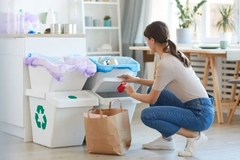EU SUPD enters into force: Recycling receives regulatory boost amid Single Market fragmentation concerns

08 Jul 2021 --- With the EU Single-Use Plastics Directive (SUPD) entering into force on July 3, PackagingInsights sits down with Francesca Stevens, managing director at The European Organization for Packaging and the Environment (Europen) and Antonino Furfari, managing director at Plastics Recyclers Europe, to discuss the legislation’s impacts on the packaging industry, waste management and single-use plastic alternatives.
The SUPD has banned the ten most commonly found single-use plastic items on European beaches, representing 70 percent of all marine litter in the EU when combined with fishing gear. The items banned include single-use plastic cutlery, plates, straws and stirrers, plastic bags, packets and wrappers, and expanded polystyrene food and beverage cups and containers.
The legislation also focuses on limiting single-use plastic consumption by introducing design requirements like tethered caps, labeling requirements informing consumers about a product’s plastic contents and disposal options, and introducing waste management and clean-up obligations for producers, including extended producer responsibility (EPR) schemes.
Single Market fragmentation
Europen, and the packaging value chain it represents, support the overarching objectives of the SUPD for taking decisive action against plastic litter and raising awareness among EU citizens.
“At the same time, we consider it critical to ensure the harmonized, consistent and proportionate transposition of the Directive at the national level so the environmental goals can be attained most effectively, while ensuring measures adopted in a single Member State do not introduce barriers to the free movement of packaging and packaged goods across the EU,” stresses Stevens. The SUPD has banned the ten highest polluting single-use plastic items in Europe.
The SUPD has banned the ten highest polluting single-use plastic items in Europe.
“Unfortunately, we see more and more cases of Single Market disruptions stemming from the unharmonized national transposition of the Directive. These divergent national measures can, and in some cases already are, undermining the integrity of the Single Market.”
“This will have negative impacts not only on the free flow of packaging and packaged goods but also on investments and economies of scale needed to reduce plastic waste and support the circular economy transition.”
European Plastics Converters (EuPC) has also warned SUPD legislative processes are creating “an unprecedented fragmentation among EU Member States,” with the Directive’s “strict timeline” making Single Market fragmentation “unavoidable.”
A boost for recyclers
Meanwhile, Plastics Recyclers Europe says the new measures and targets give the plastic recycling industry the confidence to continue investing in higher quality recycling.
The SUPD’s targets include a 77 percent separate collection target for plastic bottles by 2025, increasing to 90 percent by 2029. The targets also include incorporating 25 percent recycled plastic in PET beverage bottles from 2025, extending to 30 percent in all plastic beverage bottles from 2030.
“With an abrupt halt of global economic activity and consequently a record drop in oil prices during the pan-European lockdowns, many recyclers were faced with a severe cut in demand as recyclate prices were too high compared to those of virgin plastics,” explains Furfari.
“Consequently, recyclate demand in almost all end-applications, except beverage bottles, registered a substantial lower demand.”
“Demand for food-grade recycled PET was the least impacted polymer thanks to the recycled content targets set by the SUPD. It has sustained this crisis much better in comparison to other recycled materials since brand owners are gearing up for the 2025 and 2030 targets for beverage bottles and, therefore, suffered less from plummeting oil and virgin prices.”
Furfari adds that the EU’s use of deposit return systems (DRS), targeting a 90 percent collection rate for beverage bottles by 2029, will also help guarantee a stable supply and demand for recycled plastic. Plastics Recyclers Europe says the SUPD’s recycling targets will boost the recycled content market.
Plastics Recyclers Europe says the SUPD’s recycling targets will boost the recycled content market.
Guideline delays
EuPC has also voiced concerns over the nearly one-year delay on the release of the SUPD guidelines – which eventually published at the end of May – warning it has already resulted in “the first signs of scattered and unharmonized transposition scenarios” throughout the EU.
Stevens at Europen echoes this concern and adds that the European Commission (EC) is still expected to publish several supporting acts, such as the guidelines on determining the litter clean-up costs to be covered by producers and the methodology for calculating and verifying plastic reductions.
“These delays are resulting in divergent national implementation paths and aggravating the risk of gold plating by Member States,” she explains.
“Another concerning aspect is linked to the persisting ambiguities regarding the interpretation of the concept of ‘placing on the market’ in the context of the implementation of the SUPD harmonized marking requirements.”
“Limiting the time available for economic operators to exhaust the existing stocks by forcing a very narrow interpretation of the meaning of ‘placing on the market’ will not only have a disproportionate negative economic impact but risks leading to the destruction of existing unmarked stocks, resulting in an unacceptable waste of resources.”
Caution over alternatives
Furfari highlights that while it is important to respect the EU waste hierarchy, the proposed alternatives to single-use plastics must have a proven circular and environmental benefit.
“In practice, it means prevention is the first choice when considering placing a product on the market, followed by reuse and recycling.”
“At the end of their lives, these materials must be effectively collected, recycled into high-quality materials and have end-markets.”
“Additionally, the whole life-cycle must be looked into, where, for example, the carbon footprint impact is assessed. This is necessary if we are to move to a circular economy.” Europen stresses that plastic alternatives must have proven circular and environmental benefits.
Europen stresses that plastic alternatives must have proven circular and environmental benefits.
PackagingInsights recently discussed the rise of disposable, fiber-based packaging within the SUPD context with leading suppliers PulPac and Zume.
“Future targets, definitions and requirements need to provide sufficient visibility to drive investments into new packaging solutions, reuse schemes and waste management technologies,” adds Stevens.
“Rather than imposing bans or restrictions on specific packaging materials or formats, policies should strive to ensure they can become reusable and recyclable in the immediate future.”
Waste management reviews
The battle against plastic waste is a fast-developing area, with the EU planning to review the SUPD in 2027. The review will include assessing the scientific and technical progress concerning a standard for plastic’s marine biodegradability.
However, before the SUPD review, the EU is undertaking a “massive revision” of its Packaging and Packaging Waste Directive, the main piece of legislation governing all packaging and packaging waste in the EU, Stevens points out.
“A proposal by the EC for its review is expected already by the end of the year. This can represent a real milestone in the process of moving toward a sustainable packaging value chain in Europe,” she explains.
“To succeed in this shared effort, the regulatory framework must be fit for purpose to effectively prevent packaging from becoming waste by boosting recyclable and reusable solutions while preserving packaging functionalities.”
“Packaging of the future will have to be reusable or recyclable in an economically viable way, support the EU climate goals and continue to provide safe and sustainable products to consumers.”
By Joshua Poole











